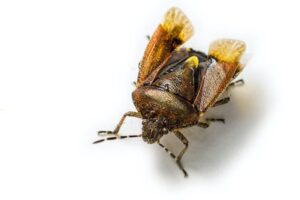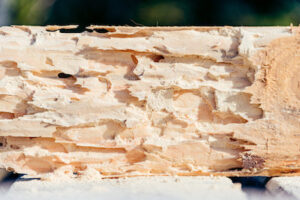Best Ways to Get Rid of Carpenter Beetles
Carpenter beetles can be a major pest in your home. Carpenter beetles are one of the most infesting species that can be found within homes. They’re not only annoying but they do damage to your home. The next time you see one, don’t worry! There are several natural ways to get rid of them so you don’t have to resort to toxic chemicals.
So, how can you naturally get rid of carpenter beetles? Several natural methods work to get rid of carpenter beetles including making traps out of household items, using diatomaceous death, insecticidal soap, neem oil, and more!
Keep reading to learn more about natural methods for getting rid of carpenter beetles in your home.
8 Natural Ways to Get Rid of Carpenter Beetles
If your home does already contain carpenter beetle larvae present, what should you do? Fortunately, there are several natural options available for those who prefer organic treatments over chemical ones.
- Make traps out of household items such as using tuna fish cans or other containers, fill them with a mixture that consists of 1/8 cup apple cider vinegar, 1/8 cup vegetable oil and 4 drops lavender essential oil then place it somewhere near the problem areas
- Use diatomaceous earth around all openings and cracks where carpenter beetles may come into your home, this is a powder-like substance that will be very difficult for them to cross.
- Spray insecticidal soap to the affected areas since carpenter beetles are soft-bodied insects, this is one of the best ways to get rid of them without using anything harsh or harmful to your family.
- Use pyrethrin spray since it’s a natural extract from chrysanthemum flowers and contains no chemicals, this organic oil will kill all insects but won’t cause any harm to humans or animals when used as directed.
- Include neem oil in your mix which not only kills insects but prevents their return for three months so you won’t have a reoccurring problem.
- Grow plants that repel them naturally. Certain plants produce chemicals called pheromones which prevent insects from entering the area or even attacking it. Some of these include catnip, basil, lavender, lemon balm, and spearmint.
- A simple but effective option for ridding your home of these beetles is vacuuming the spaces that carry the evidence of their presence. Using heat and temperature treatments that either heat or cool the places that they are located in to kill these beetles are other ways to clear them from your home.
- Gather them up and throw them out, since removing the insects at their source will prevent them from coming back.
Why Are They Called Carpenter Beetles?
Carpenter beetles get their name from their ability to dig through wood, often resulting in the formation of tunnels inside infested trees. Though they do not eat wood, carpenter beetles bore into it to care for their larvae. These pests were named after the holes they leave behind on trees and wooden structures.
On average, carpenter beetles measure only 20-30mm in length but that doesn’t stop them from being one of the largest insects found in North America! While their wingspan is even shorter than their body length (only 12-15mm), this fascinating bug is an excellent flyer. They have enough speed to catch prey on the wing.
They’re also different from most other insects you might find both inside or around your home since they have straight antennae that are distinctly harder than their eyes.
Carpenter Beetle Defining Features
 A carpenter beetle’s head is hidden under its elytra (hardened forewings) upon which some lines are running down like an upside-down “T”. Its color ranges from black with yellow markings or dark brown.
A carpenter beetle’s head is hidden under its elytra (hardened forewings) upon which some lines are running down like an upside-down “T”. Its color ranges from black with yellow markings or dark brown.
You can tell them apart from other bugs by this pattern on their wings; no other bug has anything like it! Adult carpenter beetles emerge during early autumn and hibernate during the winter.
They are most active around spring and summer. Sometimes, however, they can be seen crawling on windowsills if they get too cold.
Carpenter Beetle Larvae
The larvae of these insects have a brown appearance with some being cylindrical while others appear flattened. They also have tubercles on their bodies which are typically adorned with long hairs. Their heads feature two narrow antennae segments, as well as large mandibles which are used for chewing wood.
Unlike their adult counterparts, the larvae of these beetles do not have legs and therefore cannot move from one location to another. For this reason, they require a food source that is nearby and easily obtained.
Infestations can be difficult to see. Because of this, many people may wait until their home has been severely damaged before taking any action. However, by implementing preventative measures such as vacuuming regularly and using cedar-based products, you can avoid an invasion later on down the road.
Adult Carpenter Beetles
Carpenter beetle larva feed within the tunnels where they live. Female adults bore holes in trees or wooden surfaces of homes to lay their eggs, while male adults fly in search of a mate. The beetles inject larvae with an enzyme that softens wood so it can be eaten easily. This process takes place immediately after laying eggs.
Larvae then hatch and eat their way through this softened wood until they reach maturity about 2 weeks later. Fully grown carpenter beetle larvae are white to cream-colored, legless grubs up to one-and-a-half inches long. After mating and developing into adults, the larvae pupate and weave a cocoon of wood particles before transforming into an adult beetle.
Carpenter beetles will eat other trees if they can’t find any suitable wood to bore into within their immediate surroundings. This is especially true among those that live in the cold climate. These pests don’t adapt well to freezing temperatures.
When carpenter beetles stray from infested trees, they will crawl onto nearby buildings and bore into siding, soffits, decks, and fascia boards. Their presence provides easy access for other pests such as ants and roaches. It’s important to get rid of them immediately upon discovery before they spread further and cause more damage than necessary!
Carpenter Beetle Hiding Places
You might have discovered larvae in the walls of your home, or you may have seen adult insects on windowsills. Larger than most common household bugs, these wood-boring pests can be identified by their antennae, heads, and thoraxes which are narrower than their abdomens.
Though they are not known to carry or transmit diseases, their presence is unwelcome. These pests are mainly seen in homes with wood-based fixtures and flooring. The reason for this is because carpenter beetles lay eggs deep within the surface of the wood. Here their larvae feed on it until reaching maturity.
Signs of Carpenter Beetles
 Carpenter beetles carry a white, spongy material called frass. You may find it in the cracks and crevices of your home. This is generally the most visible symptom these insects leave behind as they burrow to create tunnels beneath wood where they lay their eggs.
Carpenter beetles carry a white, spongy material called frass. You may find it in the cracks and crevices of your home. This is generally the most visible symptom these insects leave behind as they burrow to create tunnels beneath wood where they lay their eggs.
After hatching, young larvae transform into pupae before emerging as adult beetles. These new adults can then mate and create more larvae, starting the entire process over again.
Some carpenter beetle species may be more difficult to spot than others. Sometimes they are even mistaken for bumblebees! And while some infestations of these insects are minor, their destructive tendencies mean that they must be dealt with promptly.
What Are the Health Risks of Carpenter Beetles?
Just like termites, carpenter beetles can cause structural damage to your property if not treated quickly. They may seem more harmless than other pests due to their larger size. However, these wood-boring insects spread through your home and lay eggs that hatch into damaging larvae.
If you see evidence of frass present in the cracks and crevices of your home’s exterior or inside walls, contact a pest control company immediately. Their presence will result in weakened floors, warped window frames, and broken furniture. Not to mention potential safety hazards caused by falling debris.
They also pose serious health risks since their frass can contaminate food sources and spread dangerous bacteria – and their bite is known to be painful and lead to infections.
If you spot these insects inside your home it is important to dispose of any food you can’t safely store and keep all surfaces clean. This will help prevent further infestations. It will also prevent the spread of bacteria that could affect those with compromised immune systems or allergies.
When t0 Contact the Professionals
 Well, there you have it – eight natural ways to get rid of carpenter beetles! The best part about these methods is that they are all chemical-free and safe to use around family and pets.
Well, there you have it – eight natural ways to get rid of carpenter beetles! The best part about these methods is that they are all chemical-free and safe to use around family and pets.
And remember, if you do find evidence of carpenter beetles within your home, the first step should always be contacting a professional exterminator for their opinion on what course of action should be taken.
